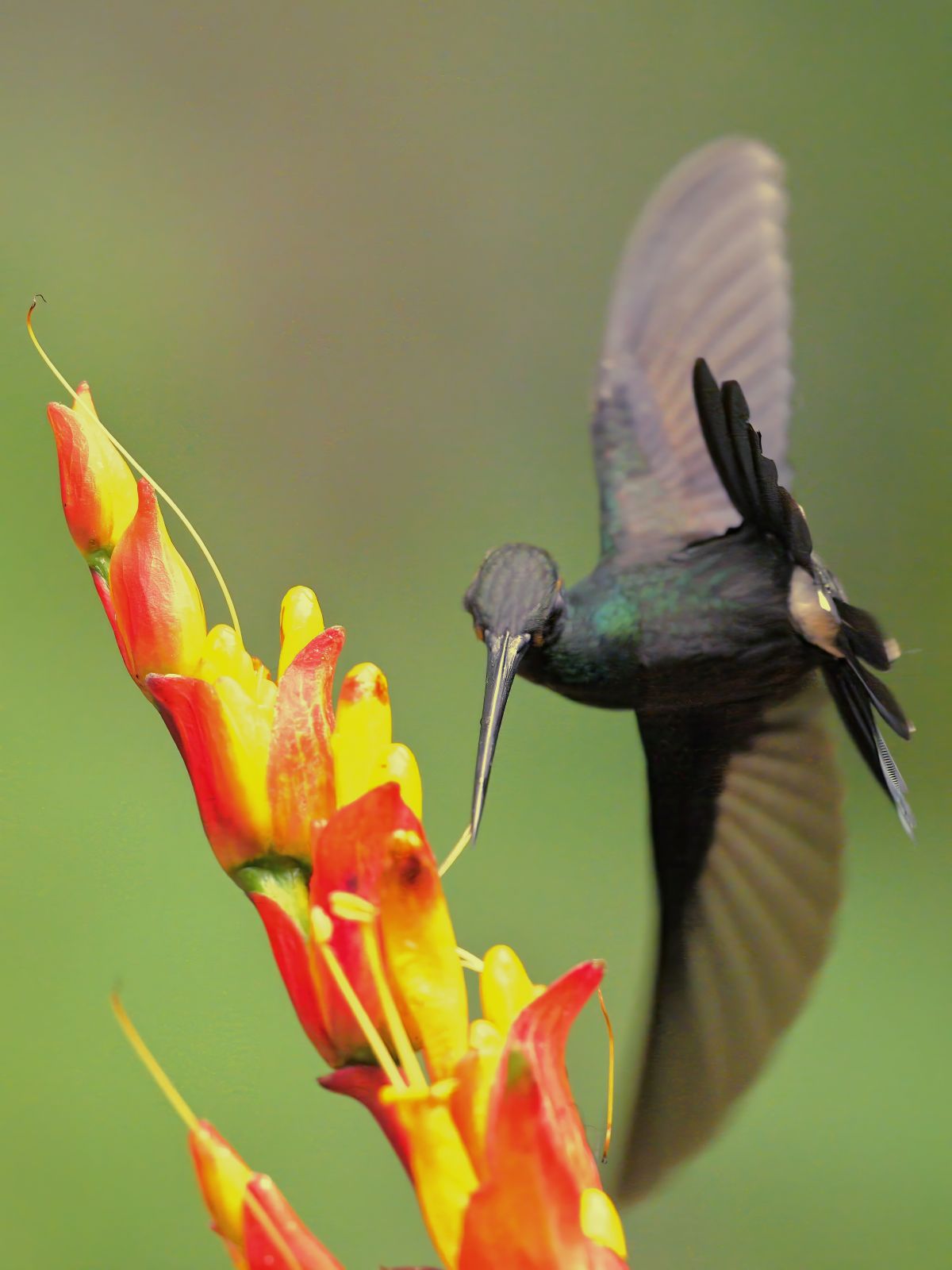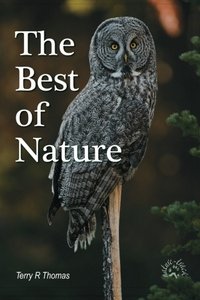Tails

©Terry R. Thomas/www.nature-track.com
A hummingbird uses its tail as much as its wings for intricate and complex maneuvers.
While photographing hummingbirds in Ecuador, I sometimes set my camera to 20 frames per second and shutter speeds of 1/4000 second to hopefully capture the perfect moment. That seldom worked, but it did provide me with an opportunity to see into the flight skills of a hummingbird, something our eye usually just registers as a blur.
One thing that I noticed was the incredible ways the birds used their tails in their wonderful acrobatics. Tails appeared to be as important as wings in maintaining direction, stopping in mid-air, and tight maneuvering.
This got me thinking about the tails of other birds and other animals. A tail may be the most universal and yet the most variable appendage in the animal kingdom. While tails are largely considered a feature of vertebrates, animals of every class, from bacteria to mammals, have tails.
With that in mind, it is difficult to say just what, exactly, is the purpose of a tail. An ovipositor for instance, used to place eggs (Mormon crickets, some wasps, grasshoppers, katydids and more) is not a tail. There are so many variations and uses of that appendage, that a tail almost defies definition except as to where it is located: “The tail is the elongated section at the rear end of a bilaterian animal's body; in general, the term refers to a distinct, flexible appendage extending backwards from the midline of the torso (Wikipedia).”
One use of a tail (and a tail may serve several purposes) is for a weapon or for defense. The scorpion readily comes to mind here as its stinger/venom equipped tail can be used for both. Another animal with a defensive stinging barb on the end of its tail is the stingray. This is the very animal that felled Steve Irwin, The Crocodile Hunter, in 2006 by stabbing him in the chest.
Defensive tails have been around for eons though. The long extinct stegosaurs and ankylosaurs were armed with spiked and clubbed tails to defend themselves against fearsome predators that we can’t even imagine.
Another style of defense is that of the rattlesnake. Its tail is made of hollow interlocked segments made up of keratin, the same material that constitutes a human nail. The segments fit loosely inside one another at the end of the serpent’s tail and when the tail vibrates, a hollow unmistakable warning rattle ensues.
When a snake uses its tail to lure prey into thinking it is a worm or other prey (used by at least 50 species of snakes, but also documented in some sharks and eels), it is called caudal luring. This can range from simply dangling a twitching tail, to that of the Iranian spider-tailed viper which has a tail that literally looks like a spider.
North American beavers have a unique, broad and flattened scaly tail. This tail is useful as a rudder in swimming, for balance on land and to signal danger when slapped on the water. Beavers will also store fat in their tails so they can survive through winter when food is scarce. The beaver's vertebrae continue into and almost to the end of the tail.
Lizards use their tails in a unique way. When grasped by a predator, the tail breaks off or is “cast”, allowing the lizard to escape (the tail usually grows back). The short-tailed and long-tailed weasels do something similar. In winter these little predators are all white except for the tips of their tails which are black. Their predators tend to focus on the moving black tip, often missing the rest of the weasel.
There seems to be no end to this tale of tails. More next time.
Help Idaho Wildlife
When we traveled across the state in October 2017, we visited most of the Idaho Department of Fish and Game wildlife management areas. Most of the vehicles we saw using the wildlife management areas did not have wildlife plates. Buying wildlife plates is a great way for non-hunters and hunters alike to support wildlife-based recreation like birding.
C'mon folks, let's help Idaho's wildlife by proudly buying and displaying a wildlife license plate on each of our vehicles!
See below for information on Idaho plates. Most states have wildlife plates so if you live outside Idaho, check with your state's wildlife department or vehicle licensing division for availability of state wildlife plates where you live.
And tell them that you heard about it from Nature-track.com!

Wildlife License Plates
Great news! as of 2024, there are three NEW designs for license plates. They still are bluebird, cutthroat trout and elk, but they are beautiful.
Idaho Wildlife license plates provide essential funding that benefits the great diversity of native plants and wildlife that are not hunted, fished or trapped—over 10,000 species or 98% of Idaho’s species diversity. Game species that share the same habitats (such as elk, deer, antelope, sage-grouse, salmon, trout) also benefit from these specialty plates.
No state tax dollars are provided for wildlife diversity, conservation education and recreation programs. Neither are any revenues from the sale of hunting or fishing licenses spent on nongame species. Instead, these species depend on direct donations, federal grants, fundraising initiatives—and the Idaho Wildlife license plates.
Both my vehicles have Bluebird Plates. I prefer the bluebird because the nongame program gets 70 percent of the money from bluebird plates, but only 60 percent of the money from elk and trout plates - 10 percent of the money from elk plates supports wildlife disease monitoring and testing programs (to benefit the livestock industry) and 10 percent from cutthroat plates supports non-motorized boat access.
Incidentally, in 2014, the Idaho Legislature denied the Department of Fish and Game the ability to add new plates or even to change the name of the elk and cutthroat plates (very specific) to wildlife and fish plates, a move that would have allowed for changing images occasionally and generating more revenue. It would seem that they believe that we Idahoans don't want a well funded wildlife program.
I think it is time we let the Legislature know that Idahoan support wildlife funding and that we would like to see these generic plates come to fruition.

"WOW. What a phenomenal piece you wrote. You are amazing." Jennifer Jackson
That is embarrassing, but actually a fairly typical response to my nature essays. Since The Best of Nature is created from the very best of 16 years of these nature essays published weekly in the Idaho Falls Post Register (online readership 70,000), it is a fine read. It covers a wide variety of topics including humorous glimpses of nature, philosophy, natural history, and conservation. Readers praise the style, breadth of subject matter and my ability to communicate complex and emotional topics in a relaxed and understandable manner.
Everyone can find something to love in this book. From teenagers to octogenarians, from the coffee shop to the school room, these nature essays are widely read and enjoyed.
Some of the essays here are my personal favorites, others seemed to strike a chord with readers. Most have an important message or lesson that will resonate with you. They are written with a goal to simultaneously entertain and educate about the wonderful workings of nature. Some will make you laugh out loud and others will bring a tear to the eye and warm your heart.
Readers Write:
"You hit a home run with your article on, Big Questions in Nature. It should be required reading for everyone who has lost touch with nature...great job!" Joe Chapman
"We enjoyed your column, Bloom Where Planted. Some of the best writing yet. The Post Register is fortunate to have your weekly columns." Lou Griffin.
To read more and to order a copy, click here or get the Kindle version
Copies are also available at:
Post Register
Island Park Builders Supply (upstairs)
Barnes and Noble in Idaho Falls
Harriman State Park, Island Park
Museum of Idaho
Valley Books, Jackson Wyoming
Avocet Corner Bookstore, Bear River National Wildlife Refuge, Brigham City, Utah
Craters of the Moon National Monument Bookstore, Arco, Idaho